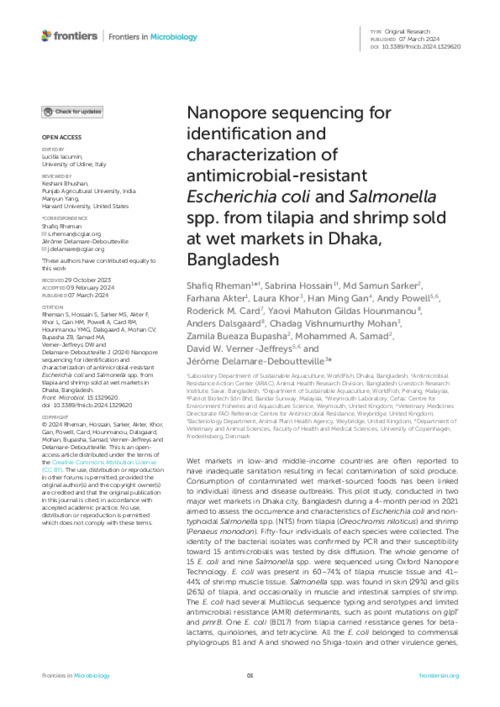Nanopore sequencing for identification and characterization of antimicrobial-resistant Escherichia coli and Salmonella spp. from tilapia and shrimp sold at wet markets in Dhaka, Bangladesh

Shafiq Rheman, Sabrina Hossain, Md Sarker, Farhana Akter, Laura Khor, Han Gan, Andy Powell, Roderick Card, Yaovi Hounmanou, Anders Dalsgaard, Vishnumurthy Mohan Chadag, Zamila Bupasha, Mohammed Samad, David Verner-Jeffreys, Jerome Delamare-Deboutteville. (7/3/2024). Nanopore sequencing for identification and characterization of antimicrobial-resistant Escherichia coli and Salmonella spp. from tilapia and shrimp sold at wet markets in Dhaka, Bangladesh. Frontiers in Microbiology, 15.
Wet markets in low-and middle-income countries are often reported to have inadequate sanitation resulting in fecal contamination of sold produce. Consumption of contaminated wet market-sourced foods has been linked to individual illness and disease outbreaks. This pilot study, conducted in two major wet markets in Dhaka city, Bangladesh during a 4-month period in 2021 aimed to assess the occurrence and characteristics of Escherichia coli and non-typhoidal Salmonella spp. (NTS) from tilapia (Oreochromis niloticus) and shrimp (Penaeus monodon). Fifty-four individuals of each species were collected. The identity of the bacterial isolates was confirmed by PCR and their susceptibility toward 15 antimicrobials was tested by disk diffusion. The whole genome of 15 E. coli and nine Salmonella spp. were sequenced using Oxford Nanopore Technology. E. coli was present in 60–74% of tilapia muscle tissue and 41–44% of shrimp muscle tissue. Salmonella spp. was found in skin (29%) and gills (26%) of tilapia, and occasionally in muscle and intestinal samples of shrimp. The E. coli had several Multilocus sequence typing and serotypes and limited antimicrobial resistance (AMR) determinants, such as point mutations on glpT and pmrB. One E. coli (BD17) from tilapia carried resistance genes for beta-lactams, quinolones, and tetracycline. All the E. coli belonged to commensal phylogroups B1 and A and showed no Shiga-toxin and other virulence genes, confirming their commensal non-pathogenic status. Among the Salmonella isolates, five belonged to Kentucky serovar and had similar AMR genes and phenotypic resistance patterns. Three strains of this serovar were ST198, often associated with human disease, carried the same resistance genes, and were genetically related to strains from the region. The two undetermined sequence types of S. Kentucky were distantly related and positioned in a separate phylogenetic clade. Two Brunei serovar isolates, one Augustenborg isolate, and one Hartford isolate showed different resistance profiles. This study revealed high fecal contamination levels in tilapia and shrimp sold at two main wet markets in Dhaka. Together with the occurrence of Salmonella spp., including S. Kentucky ST198, a well-known human pathogen, these results stress the need to improve hygienic practices and sanitation standards at markets to improve food safety and protect consumer health.